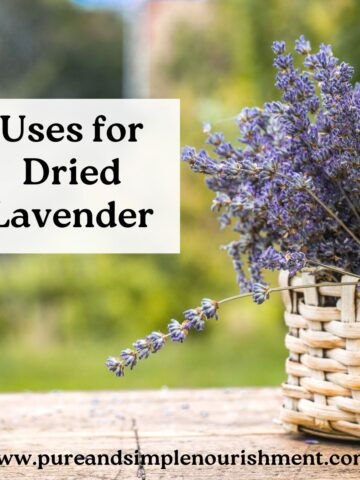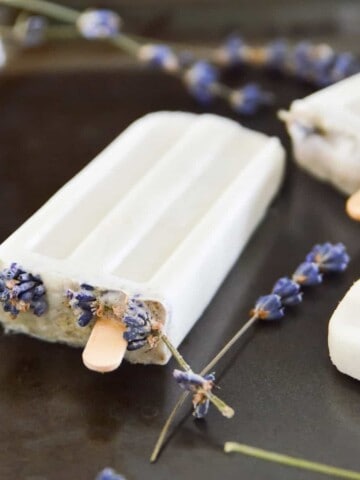Here we review the many benefits of lavender tea and how to make it - you won't believe how easy it is!

Tea made with lavender is one of my favourite warm drinks. I find it very calming, and it has many potential health benefits which is a nice added bonus. Here I will share how to make it, and the benefits, so keep reading for all the details.
And if you love learning about natural ways to help improve your health I recommend reading my posts on the health benefits of creatine.
Table of Contents
Benefits of Lavender Tea:
1. Can help with sleep
Lavender is known to be calming and relaxing and many studies have shown that smelling lavender essential oil before bed can help with sleep.
And while there haven't been as many studies done on the effects of lavender tea and sleep, one study in the elderly showed that tea made with lavender does improve sleep quality, and the effects were even greater with higher doses of the tea.
2. Helpful for anxiety and depression
Aromatherapy with lavender essential oil has been shown to be helpful for anxiety and depression, and more recent studies looking at drinking lavender flower tea also show beneficial results.
Drinking tea made with lavender has been shown to reduce both depression and anxiety scores in seniors, and the depression scores in new moms.
3. Can help with fatigue or tiredness
There was a study done with new moms who were sleep deprived (I mean what new mom isn't?), and it showed that drinking lavender herbal tea helped improve their fatigue and tiredness.
4. Can improve balance and decrease muscle spasms
A study done in patients with multiple sclerosis (MS), showed that drinking lavender tea helped improve their balance and decrease muscle spasticity.
Health Benefits of Lavender Essential Oil:
While there haven't been that many studies looking at the benefits of lavender tea, there have been many studies looking at the health effects of lavender essential oil, so I thought it was important to review those as well.
Like tea made with lavender flowers, lavender essential oil can help with sleep, depression and anxiety. But it also has a number of other beneficial effects including:
1. Can be helpful for migraines
Inhaling lavender oil has been shown to help decrease the pain from migraine headaches, and using it on a regular basis can also help reduce the frequency and the severity of the headaches.
2. Good for skin
Lavender essential oil has anti-inflammatory, antioxidant, and antibacterial properties and has been shown to be helpful for wound healing and various skin conditions including atopic dermatitis, and psoriasis.
3. Respiratory health
Inhaling essential oils (including lavender) has been shown to help treat respiratory tract infections. These beneficial effects are felt to be due to the anti-bacterial and anti-inflammatory effects of the essential oils.
4. Can help with menstrual cramps
It has been shown that applying topical lavender essential oil can help decrease the pain from menstrual cramps. The same study also found that doing abdominal massage with lavender essential oil daily for 7 days prior to the start of menstruation also reduced the length of menstruation and the amount of bleeding during the cycle.
5. Might help with diabetes
In animal studies, lavender essential oil has been shown to help protect against high blood sugar (hyperglycaemia) and diabetes and improves insulin sensitivity. It is felt that this is due to the antioxidant effects of the lavender. However, I could not find any human studies examining this, so whether these effects are applicable to humans isn't clear.
6. Can decrease pain levels
Many studies have shown that lavender essential oil can help decrease pain. For example, using topical lavender essential oil can decrease the pain at insulin injection sites in those with diabetes. It has also been shown to help decrease pain levels after surgery including decreasing pain after knee replacement surgery, C-section, episiotomy, and breast biopsy surgery.
Some studies also show that lavender essential oil can help reduce the pain associated with labour and childbirth (although not all studies looking at this have shown the same result).
7. Helpful for nausea
Inhaling lavender essential oil has been shown to help reduce nausea and vomiting.
Risks of Lavender Tea:
While there haven't been a ton of studies on either the risks or benefits of drinking lavender tea, most of the studies done do show benefits. However, there is one published case of a patient developing toxicity and an abnormal, elevated heart rate after drinking lavender tea.
There had been some concern about lavender and tea tree essential oils causing endocrine or hormone issues in kids (breast development in boys and early menstruation in girls), but so far the research hasn't been conclusive and this only seemed to be a potential issue with topically applied essential oil products, not tea, so it's not something I am personally worried about.
How to make lavender tea:
It's really easy to make lavender flower tea. All you need is water, dried lavender flowers, and a tea ball or empty tea sachets.
If you don't have a garden and can't grow your own lavender, don't worry, you can buy dried lavender flowers online. Or if you are looking for an even easier option you can buy already made lavender tea bags if you would rather not make it yourself. And if you prefer a different flavour of tea, another tea option that is made with lavender is lavender and chamomile tea.
See the recipe card below for my favourite lavender tea recipe.
Jump to the RecipeMy Tips:
- You want to make sure that the lavender you are using is culinary grade meaning it is free from pesticides and any other added chemicals.
- You can make the tea as strong or as weak as you like: For a stronger tea, steep it for longer, and for a weaker tea, steep it for less time.
- For a different taste you can add other herbs or flowers such as mint, ginger, or chamomile to the tea.
- If you prefer iced tea instead of warm tea, after the tea has finished steeping transfer it to the fridge to let it cool before drinking.
Lavender tea FAQs:
No it does not. It is a herbal tea without caffeine in it.
Yes, you can use either fresh lavender flowers or dried lavender flowers to make lavender herbal tea.
Other lavender posts you will be interested in:
Recipe

Lavender Tea
Equipment
- Kettle
- Tea ball or empty tea sachet
Ingredients
- 1 cup water
- 2 tablespoon dried lavender flowers
Instructions
- Boil the water, either in a kettle or on the stovetop.
- Place the dried lavender flowers in a tea ball or empty tea sachet.
- Once the water has boiled transfer it to a mug and add the tea ball or tea sachet with the flowers in it.
- Let the tea steep for 5 minutes. Then enjoy!
Notes
- You can either serve this tea plain, or add milk and a sweetener of your choice (I like to add a little coconut milk and honey).
- If you are serving multiple people you can double or triple this recipe.
- If you add milk or a sweetener you will need to adjust the calorie count.








Leave a Reply